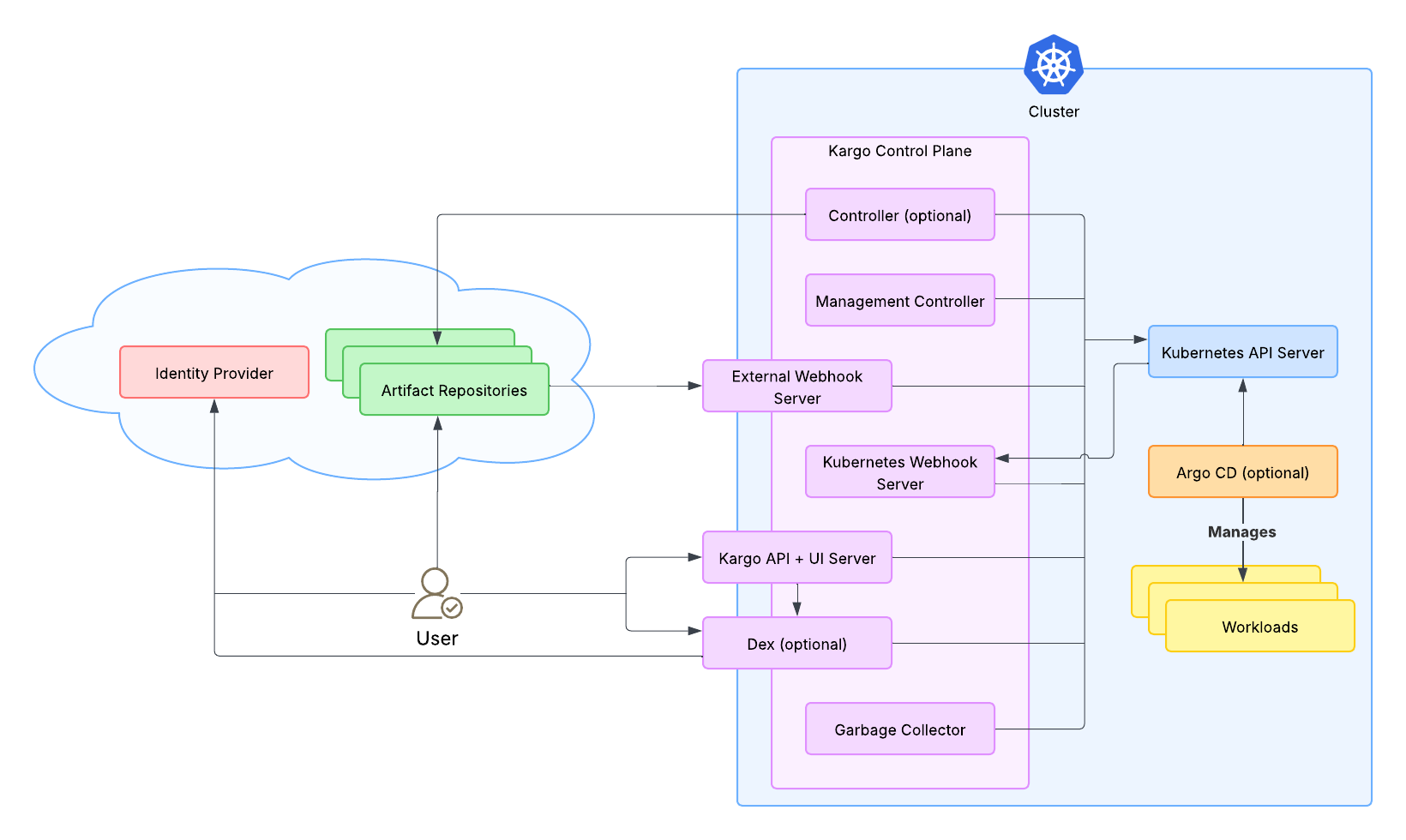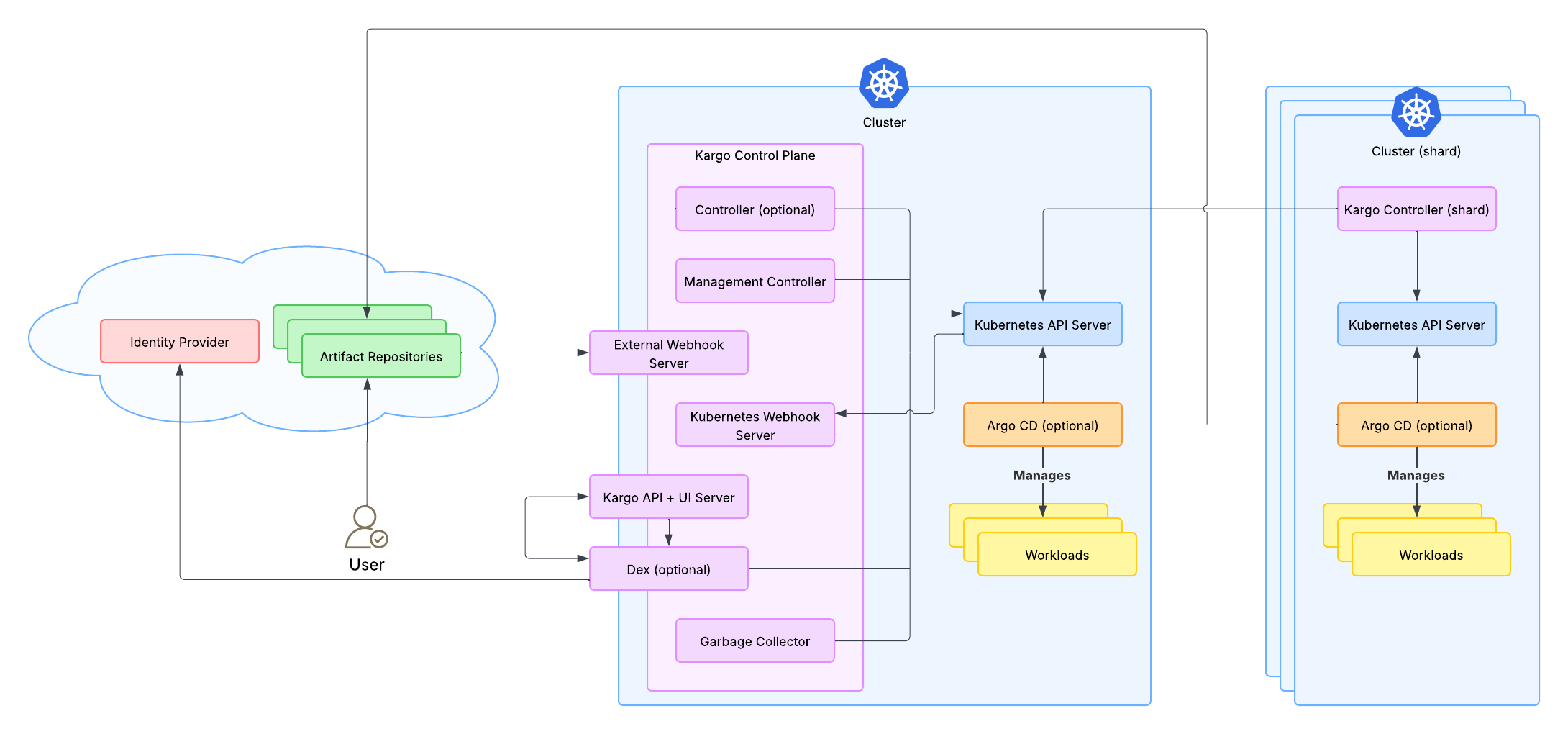Architecture and Topology
Overview
This document describes Kargo's architecture and topology, explaining how components interact in both standalone and distributed configurations. Understanding this architecture will help you grasp how Kargo achieves scalability and security through its agent-based design.
This content assumes you have a strong grasp of Kubernetes fundamentals.
Understanding Kargo's Data Model
Kargo's primary component is a custom Kubernetes controller. All of Kargo's data
is represented as Kubernetes resources -- instances of custom resource
definitions (CRDs) such as Projects, Warehouses, Stages, Freight, and
Promotions.
You can read more about the concepts behind these CRDs in the Core Concepts section of the documentation.
A Kubernetes cluster running most of Kargo's components and hosting all its data is called a Kargo control plane.
Components
The following components make up a complete Kargo installation:
API Server
Runs in: The control plane
The API server provides the back end services that both the Kargo UI and CLI depend upon. It also serves the static content for the UI, which is a single-page application (SPA).
This is one of only two internet-facing components in Kargo.
UI
Runs in: Your browser
The UI is the primary interface for interacting with Kargo. It's accessed by navigating to the API server's base address in a web browser.
CLI
Runs in: A terminal
The kargo CLI provides a secondary interface to Kargo, offering rich,
domain-specific functionality beyond what's easily accomplished with kubectl
alone.
Because Kargo's data are Kubernetes resources, it's also practical and not
uncommon for users to interact with Kargo using the standard kubectl CLI.
Controller
Runs in: The control plane and/or other clusters
This is Kargo's most important component. Controller instances perform the core work of monitoring repositories for new artifacts and executing user-defined promotion processes.
In Kargo's simplest configuration, just a single controller instance runs in the control plane. In more complex configurations, multiple controller instances are distributed across many clusters, each servicing a specific subset (shard) of data that lives in the control plane.
Why distribute controllers? Several reasons:
-
Firewalls: Some artifact repositories may only be accessible from behind specific firewalls.
-
Scalability: Distributing workloads across multiple controllers improves performance.
-
Argo CD integration: Controllers are designed to interact with the centralized Kargo control plane and, at most, one Argo CD control plane. In enterprises with multiple Argo CD control planes, Kargo controllers exist in 1:1 proportion with those Argo CD instances.
Garbage Collector
Runs in: The control plane
Absent routine cleanup, storing data as Kubernetes resources can lead to degraded cluster performance over time. The garbage collector is responsible for deleting old data.
Kubernetes Webhooks Server
Runs in: The control plane
This server implements Kubernetes validating webhooks (dynamic admission controls) and mutating (defaulting) webhooks. These webhooks are registered in the control plane cluster and allow the Kubernetes API server to hook into Kargo-specific logic as Kargo resources are created, modified, and deleted.
This webhook server is not an optional component. It is critical to Kargo's proper function.
This webhook server is not internet-facing. Its only client is the Kubernetes API server within the same cluster. It must use TLS. (The Kubernetes API server will not interact with webhook servers that do not.) Self-signed certificates are generally sufficient for this purpose.
This component is distinct from the external webhooks server. (See next section.)
External Webhooks Server (Optional)
Runs in: The control plane
This server's role is to receive and handle inbound HTTP/S requests from external systems. For example, if you configure a GitHub repository to send a request to Kargo when a new commit is pushed, this server receives that request and initiates appropriate actions in response.
This is Kargo's second internet-facing component (after the API server).
Management Controller
Runs in: The control plane
This secondary controller handles critical clerical work. One of its most important functions is dynamically managing the permissions of other components.
This is not an optional component. It is critical to Kargo's proper function.
Because some components are internet-facing (the API server and external
webhooks Server) and others (controllers) can be distributed to other clusters,
operators are often reluctant to provide these components with broad access to
sensitive resources, particularly Kubernetes Secrets in the control plane. To
mitigate this, the management controller, which is neither internet-facing nor
distributed, is granted broad permissions and dynamically expands and contracts
narrower sets of permissions for other components and Kargo users as
Projects are created and deleted.
Dex (Optional)
Runs in: The control plane
Dex is an open-source OpenID Connect identity provider (IdP). Kargo relies on third-party identity providers for user management and can work directly with most IdPs that implement the required protocols. However, some IdPs do not and Dex serves as an adapter for such cases.
Example: GitHub doesn't implement OpenID Connect at all, but Dex can integrate with GitHub while providing a compliant interface to Kargo, allowing users to sign in with their GitHub accounts.
For many IdPs, like Microsoft Entra ID (formerly Azure Active Directory), Okta, or Google Cloud Identity Platform, Dex is not needed.
In simple, "kick the tires" configurations, Kargo uses Dex's built-in mock IdP or disables integration with identity providers entirely and uses a built-in admin account instead. We recommend never enabling the admin account in production.
Topology
The Kargo Control Plane
The Kargo control plane is a Kubernetes cluster running most of Kargo's components and hosting all of Kargo's data. The control plane may include a controller instance, but controllers can also be entirely distributed to other clusters.
When controllers are distributed, each operates on a specific subset of the data in the control plane. This subset and its controller are called a shard.
Standalone Configuration
In the simplest configuration, all Kargo components, including a single controller, run within the Kargo control plane cluster:

This configuration is suitable for testing and very small-scale deployments.
Distributed Configuration
In larger environments, Kargo leverages an agent-based architecture where controllers are distributed across multiple clusters, with each controller "phoning home" to the centralized Kargo control plane:

In this configuration:
-
The Kargo control plane hosts all data and core services, but may or may not run a controller instance.
-
Controllers are distributed to individual clusters (shards), each typically corresponding to an Argo CD control plane.
-
All controllers connect back to the Kargo control plane.
-
The control plane itself has no privileged access to the clusters where controllers are deployed.
Why This Architecture?
Kargo's agent-based architecture is informed by lessons learned from Argo CD and attempts to avoid the weaknesses of Argo CD's common topologies:
Hub-and-spoke:
-
✅ High observability: A centralized control plane amounts to a "single pane of glass."
-
❌ Security risks: A centralized controller with privileged access to many clusters represents a high-value target and a single point of catastrophic failure if compromised.
-
❌ Limited scalability: A centralized controller's performance will degrade as it becomes responsible for more and more clusters.
Control plane per cluster:
-
✅ More secure: Having no centralized control plane eliminates a high value target and a single point of catastrophic failure if compromised.
-
✅ More scalable: Each controller's workload is smaller.
-
❌ Low observability: No "single pane of glass."
Kargo's agent-based architecture:
Kargo's architecture employs an agent-based approach that marries the observability of a centralized control plane with the security and scalability of decentralized controllers:
-
✅ High observability: A centralized control plane amounts to a "single pane of glass."
-
✅ More secure: Distributed controllers that "phone home" to the centralized control plane mean the control plane has no privileged access to other clusters.
-
✅ Scales well: Distributed controllers, each operating on a subset of control plane data, have smaller workloads.
Configuration Considerations
Provisioning Kargo in a distributed configuration is non-trivial and involves
creating a Kubernetes ServiceAccount in the control plane for each controller,
then distributing configuration with the corresponding tokens to the many
clusters throughout your enterprise.
Documentation for Kargo's Helm chart explains most aspects of this in great detail, but why not let the Kargo experts handle it for you?
Experienced Kubernetes operators may well succeed in provisioning Kargo in a distributed configuration as described above, but developing the automation to enable it at great scale can be a significant challenge. Kargo users operating at large scale are encouraged to consider using the Akuity Platform, which can seamlessly provision hosted Kargo control planes as well as credentials and configuration for any number of distributed controllers, which can be deployed to your own clusters in just seconds.